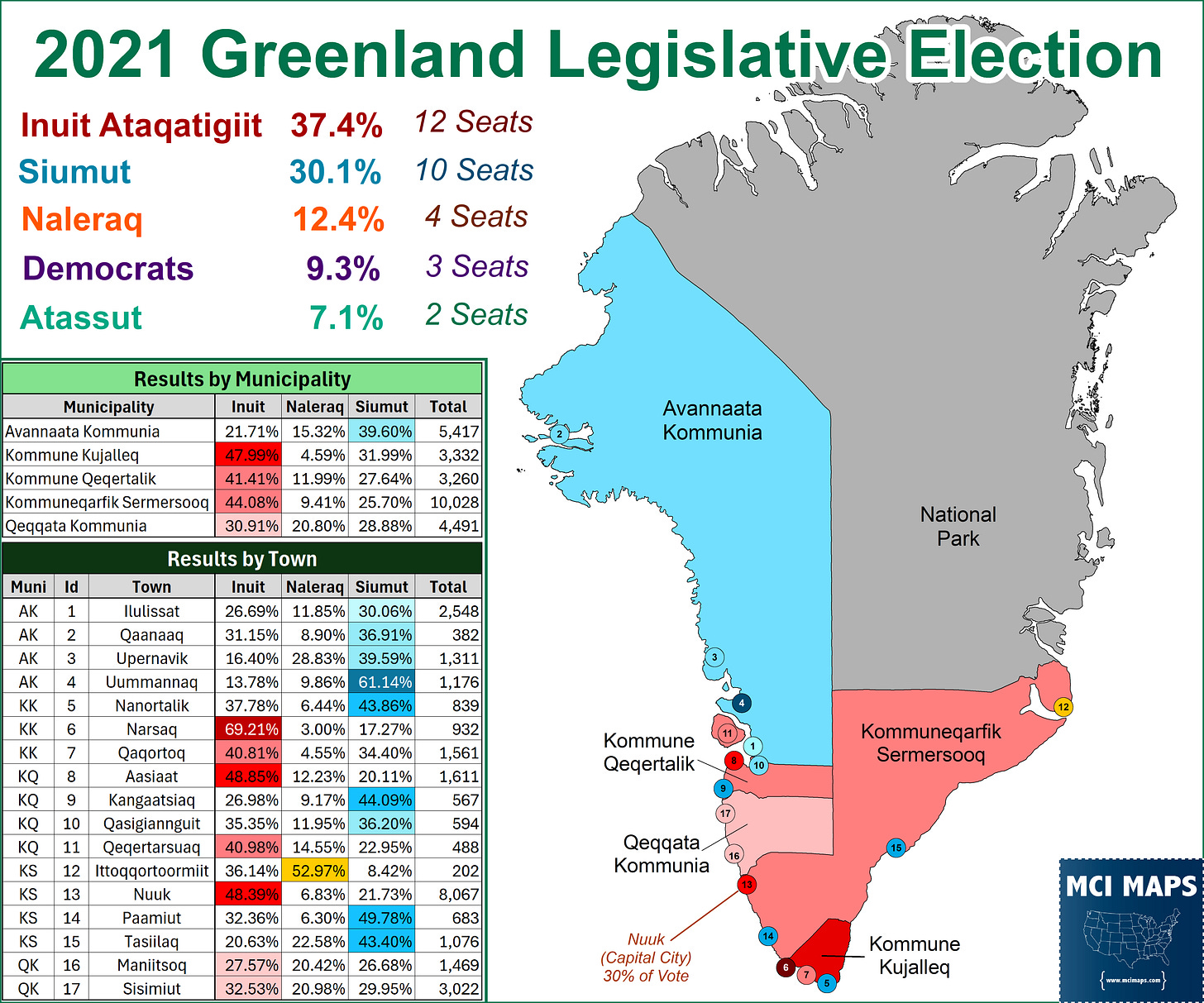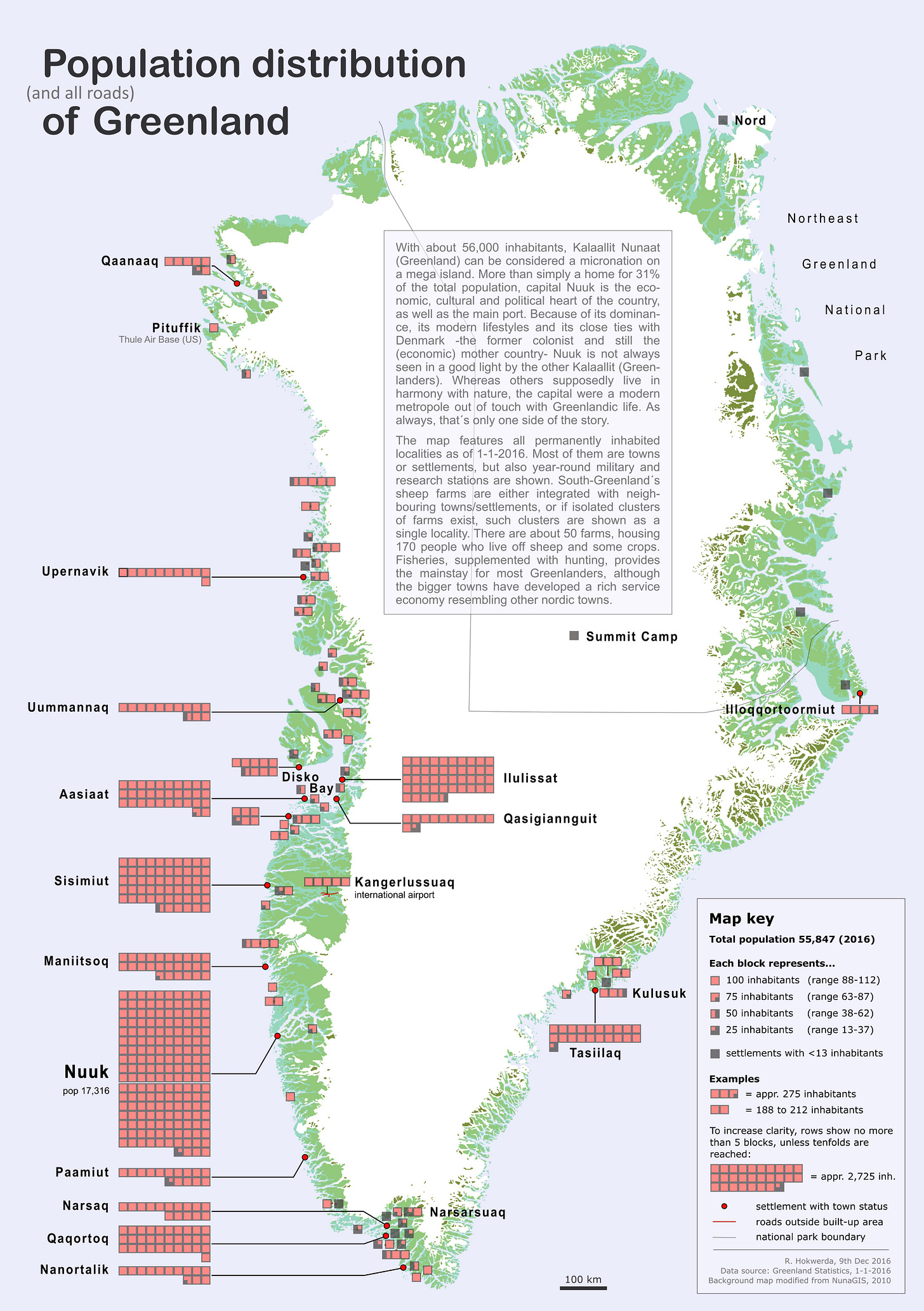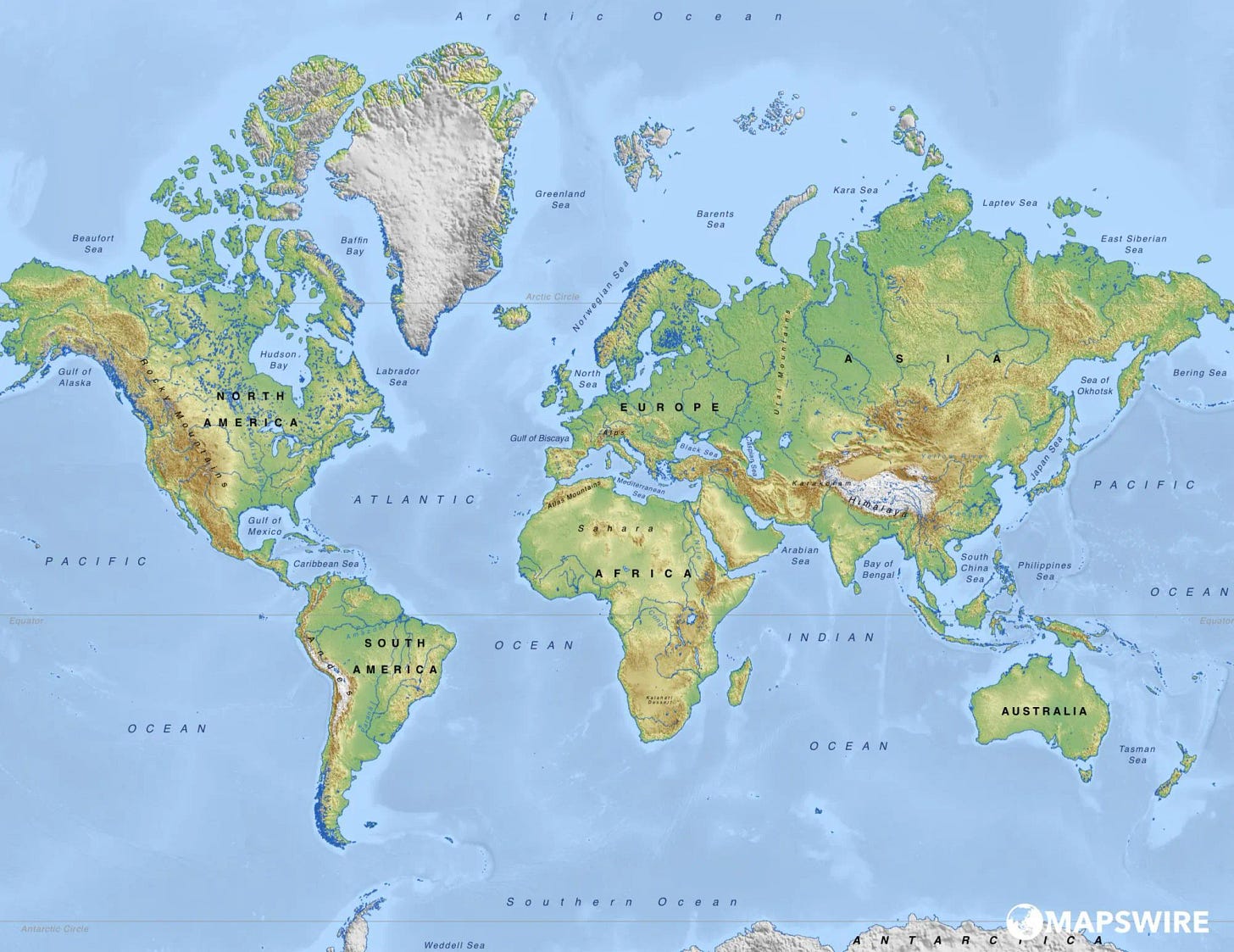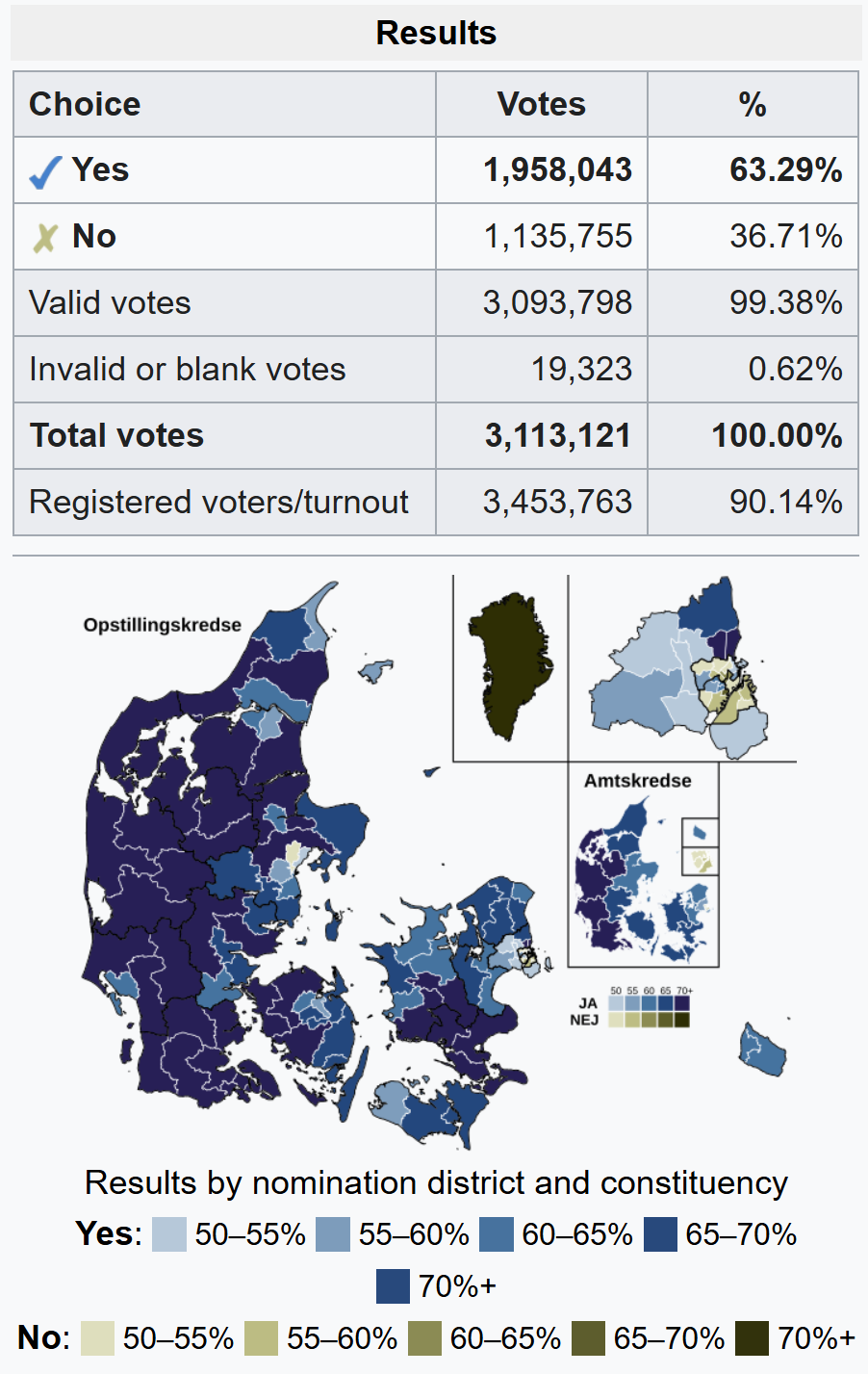Issue #232: Greenland's History & Fight for Self-Determination (Part 1)
A long history of colonial meddling
This week, voters in Greenland go to the polls for elections to their regional parliament. The autonomous territory, still formally part of Denmark, has been increasingly in the news in recent months thanks to Donald Trump.
The American President has continued to make acquiring Greenland a talking point. Trump originally broached the idea of buying Greenland back in his first term. With his return to the Presidency, he has escalated the rhetoric, insisting Greenland is vital for national security and hinting force might be used. While Trump has since scaled back the “force” talk and resumed “come on it will be great if you let us acquire you” talk - Greenland residents watch with unease.
Meanwhile, before Trump shook the election cycle up, the major topic of the upcoming election was independence from Denmark. The push for independence has continuously grown over time. In the 2021 elections, the pro-independence Inuit Ataqatigiit Party came in first.
Party politics in Greenland leans heavily toward independence or continued self-rule. The Siumut Party was the historic party of autonomy, but has been leaning more to independence with time. Naleraq is also a pro-independence party, though is more centrist than Siumut or Inuit, which are both left wing parties. The Democrats and Atassut are more pro continued union with Denmark.
NONE of these parties support Trump’s proposal to join the United States. Naleraq has been the most willing to engage with the United States on possible agreements in a post-independence world. Among the independence leaders, the biggest issue is how or when to break from Denmark. Per Danish law, Greenland has a right to become independent if they chose, and right now a solid majority of Greenlanders favor independence; and 85% do NOT want to trade Danish rule for American rule. The return of Trump’s focus on the island, however, has complicated the campaign.
But how did we get here? Why is Greenland party of Denmark? Why is Trump is obsessed with it? What drives politics on the remote island?
To answer this, I wanted to do a deep dive into Greenland history and politics. This first issue will cover the backstory of Greenland and its strugglers under colonial powers. This history shapes much of the reason for the independence push underway. It also helps explain when Greenlandic voters shave little to no interest in becoming part of the United States.
The Land of Ice
While most Americans don’t know a great deal about Greenland, the island has always been a fascination of kids playing with their globes or a map. This large island, covered by a massive ice sheet, is called “Greenland” - a nonstop riot of a joke when you are 6 years old.
Today, fewer than 60,000 people live on the island. That is, of course, do the the fact 80% of the area is covered in the Greenland Ice Sheet. Population settlements are along the coast, with the vast majority of people living in the southwest; which has the most accommodating climate for year-round living.
Greenland’s low population, couple with its massive size, means it has the lowest population density of any country/territory in the world. The island is indeed massive, right around three times the size of Texas. Of course, this is much smaller than the inflated size it is given in Mercator projection maps.
The Mercator projection, originally used for sea navigation, was a staple of my classrooms growing up. However, the projection is infamously incorrect, as it stretches the size of counties closer to the polls. It makes it seem the same size as Africa despite being FOURTEEN times smaller in reality. This whole issue of projecting a globe onto a flat map is best summarized from the classic West Wing clip: Cartographers for Social Equality.
While not the global mammoth that many maps portray it as, it is still a large land mass. However, thanks to its icy climate, it remains low populated.
That said, the lack of population has not resulted in any shortage of history.
Early Greenland History
For this section of the article, I want to give a brief summary of Greenland’s history and peoples. The story is one you will find similar to many stories of the New World.
Native North American Tribes
Like the rest of North America, Greenland has seen people live on it for thousands of years. Paleo-Inuit settlements dating back 5,000 years have been discovered on the island. One of the best known groups to settle part of the island were the Dorset, a paleo-Eskimo people that also occupied the islands of what is now Northern Canada. However, these early settlers do not make up the base of Greenland’s population today. Most of there settlements were on the top of Greenland, an area that today has little to no population.
From around 1000 AD to 1500 AD, the Thule people, who are the ancestors of modern Inuit population of the island, began to migrate from Alaska and across Northern Canada to eventually reach Greenland. Bringing over dog sledding and advanced fishing techniques allowed them to establish firm bases on the island. Today, 90% of Greenland is Inuit, tracing ancestry back to the Thule migrations.
However, like the rest of North America, native tribes had to deal with expanding European presence in the region.
Vikings and Empires
With the 10th century AD, early Norse sailors began to arrive on the island. The first documented Norse navigation of the island was in 978. Then from 982 to 986, the first Nordic settlements were set up by Eric the Red; who arrived on the island after being expelled from the Nordic colony of Iceland. Eric gave Greenland its name, purposely using a name to make it more enticing for recruits to join him in the new settlements. Settlements dotted the Southwest side of the island.

In 1263, Greenland was made a crown dependency of the Kingdom of Norway. Settlements on the islands were mainly used for trade, namely walrus ivory. These settlements would last until the 14th to 15th century, slowly becoming abandoned. Many reasons have been given for the collapse of the settlements; with little hard evidence existing for the reason. A combination of ivory competition from African elephanits, the Little Ice Age leading to worsening weather, and the Black Plague devestating Scandanivia, leading to a lack of supplies and connection to Europe.
While the Nordic settlements did not last, they were a critical historic precedent for Denmark’s claim to the island.
Danish Rule
While the Nordic settlements did not last, the area would become important to Europe once again as global exploration kicked off in the 1400s and 1500s; especially as explorers looked for the fabled Northwest Passage to get to the Pacific Ocean.
In 1537, the Kingdoms and Norway and Denmark were joined as a union; with a duel king. Then in 1721, in a the latest effort to establish control of the island, Danish-Norwegian merchants were sent to Greenland to establish a colony and see if any other old Nordic settlements survived. They had not, and the local Inuit population living and operating on the island has not had any other contact from Europe. The duel-kingdom set up new trading posts in the island.
Then in 1814, as a result of the Napoleonic Wars, Norway was forced to break away from Denmark and was instead given to the Kingdom of Sweden. Denmark kept Greenland, giving them control that they still hold today. If that is confusing, this 3 minute video perfectly sums up the games of European powers.
Of course, as all this as going on, the Inuit people of Greenland were living there. Like the dynamic in what is now Canada and America, the evolving maps of European control gloss over the fact native peoples lived on these lands.
Colonialism under Denmark
Danish control of Greenland, which was very much a colony in this period, was different from its colonial control of territories in the Caribbean; which often saw brute force to maintain control. The system in Greenland would focus on economic controls and paternalistic attitudes. The nature of this colonialism can be read in detail here, but this key passage I think summarizes things well….
In Greenland a third kind of colonialism developed. As it was difficult for the colonisers to control the sparse and mobile inuit through coercion, they had to use the carrot at least as much as the stick. From the late eighteenth century a particular kind of ‘tutelary’ colonialism developed, in which the Danes saw themselves as the guardians of a vulnerable people, who should not be too hastily exposed to the vices of the modern world. This approach was, it can be argued, the Danish version of the ‘civilising mission’ and it meant that Greenland was effectively sealed off from the rest of the world.
Greenland remained sparsely populated, hovering under 20,000 local inhabitants. Denmark formed a trading monopoly on the island and used it largely as a trading and fishing hub. As seen in the above passage, the Danes saw themselves as a “civilizing” force and Danish merchants and residents were the only Europeans the Inuit had contact with. This continued through the 1800s and into the early 20th century.
Greenland is also best known for the site of conflict in World War II and the temporary occupation by America. When the Danish Government was topped by NAZI invasion in 1940, the island was cut off. Henrik Kauffmann, the Danish Minister to the United States, signed a treaty with America to allow them to occupy the island and set bases up there. When Germany tried to set up weather stations on its east coast, Greenland formed The Sledge Patrol, a grouping of locals and sled dogs to locate and sabotage these efforts. A fight with German soldiers at one site saw at least one German and one Greenlander killed. Greenland was indeed the site of World War II fighting.
The end of World War II saw the United States make an offer to buy Greenland, seeing its strategic benefit in the cold war. This effort was nixed by the restored Denmark government. Instead, the cold war would see Denmark engage in its own form of “decolonization” for Greenland.
The End of Colony Status
The end of World War II saw a recalibration of Denmark’s relationship with Greenland. The early United Nations, which Denmark was a participant in, pushed for an accounting of colonial holdings from its member nations. Denmark worried its possession of Greenland would be looked at negatively amid an anti-colonial sentiment emerging in the post-war era. It even struggled on if it should count Greenland as a colony at all…
Although Denmark had governed Greenland as a colony, Danish civil servants and politicians were reluctant to see Greenland as on a par with other colonial territories. They argued that, as Denmark had never exploited Greenland as other European powers had done in Africa or Asia, the Charter did not apply to Greenland. Ultimately, however, Denmark did choose to report Greenland as a Danish colony.
Denmark established a commission in 1948 to examine the situation in Greenland and propose reforms. This was all undertaken as Denmark sought to portray itself as a benevolent colonial power; highlighting its “light hand” in comparison to colonial missions in Africa and Asia. This “light hand” comparison was true, but it glossed over Denmark’s un-democratic rule of the island. The local Inuit population were subject to different laws than Danish residents, the Danish monopolies continued to operate, and Denmark controlled who could even go to the island. If Denmark wanted to insist Greenland was not an exploited colony, reforms would be needed.
The Denmark-Greenland Commission worked from 1949 to 1950 on a series of studies and proposed reforms. A more detailed account can be found here, but these were the key reforms. Some were good, some proved to be very bad long term.
The establishment of a local legislative council with elections under universal suffrage
Consolidation of the population in key larger cities and abandoning small villages
Repeal of the ban on entry to the island and a repeal of the Denmark trade monopolies
Ending of different legal standards based on ethnic background
Modernization of healthcare and schooling systems
This included a push to spread the Danish language in Greenland
These reforms were eventually passed as the 1950 Greenland Act. The effects of these reforms, both good and bad, will be discussed in the next section.
Denmark’s moves toward reforming the territorial status of the island was met with positivity from the UN and both the United States and Soviet Union. Both great powers knew that if Greenland was made independent, it could risk heating up the conflict between the two. Denmark played into this, saying it was working to integrate Greenland into Denmark and end colonial status.
As its geopolitical position maintained a buffer zone between the two, Greenland becoming a new country risked provoking an undesirable chain of events in the Arctic. Most likely, the United States, thanks to its active military bases in Greenland, would fill the power vacuum created by a Danish withdrawal. A new and untested US-Soviet frontier could cause conflict. Because of this, the United States and Soviet Union accommodated Danish views and perspectives.
As the colonial debate continued in many nations, with countries like France and the United Kingdom resisting efforts to relinquish their colonies, Denmark continued to work toward incorporation. Its reform efforts allowed it to avoid the brunt of anti-colonial sentiment at the time.
Beginning of Democratic Elections
The Greenland Act brought new electoral procedures to the island. The act gave all Greenland residents Danish citizenship and established the Greenlandic Provincial Council for the island. Before this, the territory had been divided into North and South jurisdictions, each electing a local council. However, these early elections were among just the Danish settlers. The new law allowed all adults over 23 (the Danish age limit at the time) to cast ballots. In addition to the new unified local parliament, regional councils with elections were also established.
The 1951 Elections for the Greenlandic Provincial Council were held on June 29. The island was divided into 13 single-member districts using first-past the post. All winners were native Greenlanders, with Danish residents only winning a few regional council posts. The winners of each district, taken from this contemporary account, can be seen below. Thanks to FPTP and a large candidate pool, few districts saw the winner secure 50%+ of the vote.
In 1953, Denmark voters approved a new constitution. One of the provisions of this document was moving Greenland from Colony status and making it a county of Denmark. The island was to be given two seats in the Danish parliament, with a status similar to what my American readers would see as a US State. The first Danish election that Greenland participated in was that September.
In 1954, the United Nations signed off on the new system and declared that Greenland was not a colony of Denmark.
The Damage of “Danification”
Even with the end of territory status, much of the decisions for the island were left in the hands of the Danish Government. With this new era, the Danish government undertook a major effort toward the “Danification” of Greenland. This plan could be spotted in the 1950 report, which emphases teaching the Danish language and sending Danish teachers to Greenland. Denmark viewed the local Inuit population, largely subsistence fishermen and seal hunters, as needing their modernization. Reports from the time indicate reformers saw things like not knowing Danish, instead speaking local Greenlandic dialects, as a major problem.
The principle idea was to make Greenland as prosperous and modern as Denmark. However, these efforts, like so many heavy-handed efforts by a central government far from the area in question, only damaged Greenlandic society. The efforts to import Danish culture, rather than just focusing on infrastructure and civil improvements, led to major problems. I’ll discuss specifics but this video offers a very good overall account of the problems Danification caused.
Greenland, for its entire existence, has been a sparsely populated land with different villages either working together or in isolation. Part of the Danification push saw pushing people to move into the core cities where handfuls of industry existed. Efforts to establish semi-European style towns on the island only served to disrupt Greenlandic family and cultural life. Imagine the culture clash of taking families that have been subsistence hunters for generations and sticking them in cramped apartments in a city so that they can go work in a factory or commercial fishery operation.
Danes led much of the civil service, for example making up 80% of teachers. Pushes to have Greenlandic children spend time in Denmark to learn Danish customs were undertaken - program known as the “Little Danes.” If all of this sound familiar to the assimilation efforts in Canada and the United States toward Natives, you are not wrong. If “assimilation” here also sounds like “eradicating local customs and culture” - you are also not wrong. Like those efforts, the result was a disaster. Rates of substance abuse, broken families, and suicide rose exponentially in from the 1960s through 1980s in Greenland. Alcoholism became so bad that in 1978 a referendum was held on whether to ban or ration alcohol on the island, with rationing winning out.
While some Danish efforts were well-intentioned but driven by paternalistic attitudes, other efforts were downright vile. Only in recent years as the Spiral Case become subject to widespread knowledge. This is a phrase for the IUD campaign that the Danish government undertook in Greenland in the 1960s and 1970s. Over that time, thousands of Greenlandic girls had IUDs put in them without their knowledge or consent. The reasoning was the Danish government wanting to slow population growth on the island. The scandal has been referred to as a genocide by many modern Greenland politicians.
The Spiral Case is only in the public consciousness in recent years. However, back in the 1960s and 1970s there were already plenty of reason for Greenlandic residents to be unhappy with the Danish control of the island. As efforts from Denmark came to “Danify” the island, a counter-push for “Greenlandification” of the island started to emerge. The Civil Rights push in America in the 1960s gave further inspiration to those in Greenland seeking more autonomy and to protect their cultural heritage.
It is argued, however, that the biggest factor in the push for home rule came thanks to the European Union.
The EU Referendum
While the problems of Danification would continue to fuel a push for autonomy or independence in Greenland, the issue that arguably pushed this as quickly as they did was the European Union. In 1972, Denmark held a referendum on joining the European Economic Community. Integrating Greenland’s small and unique economy into the broader continental system was opposed on the island; with many residents concerned they’d lose controls that prevented over-fishing. The last thing Greenland wanted was European fishing vessels off their coast.
When Denmark voted to enter the EEC, Greenland specifically voted against it by over 2-1.
Greenland being forced into the EU market despite its firm opposition and localized concerns led to a massive push for more self-governing authority. The referendum was the perfect example for backers of Home Rule and/or independence to use. Greenland did not want to be part of the ECC, but it was being dragged into it anyway.
The vote came at a time where a new generation of Greenlandic activists were coming of age. The practical impacts of the ECC aside, and if any reforms could be offered, were secondary to a broad frustration with Danish control of Greenlandic affairs and the conflicts around Danification of the island. The ECC referendum is hence viewed as the spark that finally ignited a simmering frustration that was building on the island. The chain of events leading to autonomy would almost surely have come anyway, but the 1972 referendum sped that process up.
It was in this timeframe that the modern political party structures of Greenland began to form. Home rule would come by the end of the decade and a new era for the island would begin.
That shift will be covered in Part 2!









Fascinating stuff and great context for the "Greenland issue." Thanks for sharing your relentless curiosity.